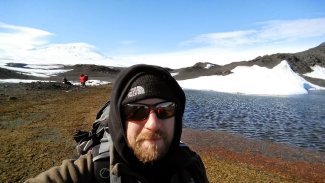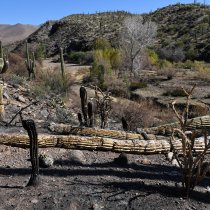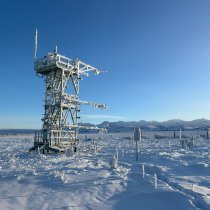Spotlight
Battelle Research Scientist Eric Sokol Studies Antarctica in Cross-Disciplinary Fashion
March 14, 2023
Read the original post on Inside Battelle.
If you travel to the southern reaches of the Earth, you could find yourself in Antarctica on Ross Island. On this desolate island, at the foot of a smoking volcano known as Mount Erebus, is McMurdo Station, the largest research outpost on the Antarctic Continent.
Across a wide sound lies a uniquely snow free area on the Antarctic mainland known as the McMurdo Dry Valleys. Here researchers are studying a polar desert which is one of the coldest, driest ecosystems on the planet. The relative simplicity of this ecosystem makes it a perfect natural lab for the science of early detection of climate change and may even provide an analog of the surface of other planets.
Much of this work is associated with the McMurdo Dry Valleys Long Term Ecological Research (MCM LTER) Project, an interdisciplinary study of the aquatic and terrestrial ecosystems. In 1992 this area in Antarctica was selected as a study site within the National Science Foundation's (NSF) Long-term Ecological Research (LTER) Program. It is here that Battelle Senior Ecologist Eric Sokol, who has worked at the National Ecological Observatory Network (NEON) since 2017, has focused much of his attention and studies. His work allows him to be both a research scientist and a data scientist, collaborating with colleagues from the MCM LTER from universities around the country on NSF grants to gather and produce ecological data and generate interpretations.

Eric Sokol with colleagues sampling mats near ponds on Cape Royds on Ross Island, Antarctica. Mt. Erebus is in the background.
Sokol began his career with an interest in understanding how stream insects could be used as bioindicators to discern stream health. While earning his PhD at Virginia Tech, he studied freshwater ecology, with a focus on aquatic insects in headwater streams in the southern Appalachians. Gathering data is a great first step, but its effective use for prediction requires modeling and statistics. Sokol’s career began to lean heavily in this more analytical direction leading him to work as a postdoc with the MCM LTER and co-author several successful proposals to study the biodiversity of microbes in Antarctica.
“My recent and current work focuses on using ecological theory to create models about where different sentinel taxa can be found in Antarctica and then testing the models with data collected by the MCM LTER and from satellites,” he said.
With colleagues Jeb Barrett from Virginia Tech, Mike Gooseff at the University of Colorado Boulder, Mark Salvatore at Northern Arizona University and others, Sokol utilizes satellite imagery provided by the Polar Geospatial Center at the University of Minnesota and runs it through various ecological models.
Sokol has made five trips to the McMurdo Dry Valleys, all during austral (Southern Hemisphere) summer as it’s the only time of year when the biota he studies are active. “You want to collect samples and measure flow in the streams when that’s happening,” he said.
To access the microbial mats in the dry valleys, researchers take a helicopter over the frozen ocean to locations where glacial rivers flow into a chain of lakes. “The dry valleys are pretty simple compared to temperate ecosystems, so people test hypotheses and theories of ecology,” he said. “It’s really interesting stuff. The streams only flow for a small part of the year. There are no vascular plants.”
Microbial mats (in the foreground with rocks) in the Canada ASPA (Antarctic Specially Protected Area), next to Canada Glacier, in the headwaters of Canada Stream. This is the most productive and biodiverse area in the McMurdo Dry Valleys.
There’s a group of people who think this area can be viewed as an analog for what life might look like on other planets. “This ecosystem gives us clues of what to look for when searching for life on other planets,” Sokol said.
Because there are no vascular plants in these ecosystems, the microbial mats and mosses play a critical role as the major primary producers. “It’s challenging and expensive to explore the dry valleys on foot to find these microbial mats,” he said. “The satellite imagery is very useful for identifying new areas of biological activity that were previously unexplored. There’s a very distinct signature of plants that are photosynthesizing. You can see these areas lighting up the imagery. Importantly, these mats provide a sentinel ecosystem. They will respond to climate change if things are happening in the dry alleys, providing us with an early indicator.”
The ecological relevance of the work done on these NSF projects mirrors NEON in many respects, giving Sokol the chance to act as both a data user and data provider for projects focusing on macrosystems scale scientific questions.
At NEON, Eric is primarily a data scientist. He works closely with the NEON user community to find ways to solve standing problems by leveraging the open-source data provided by the 81 widely distributed terrestrial and aquatic NEON sites. He wears both a science hat and a data provider hat, wrangling data and working with the user community. “There’s a lot of overlap in tools for accessing the data on both sides,” he said. “Ecologists often struggle with what are the best ways to get data into models. It’s useful when I’m both the researcher and the data provider.”


